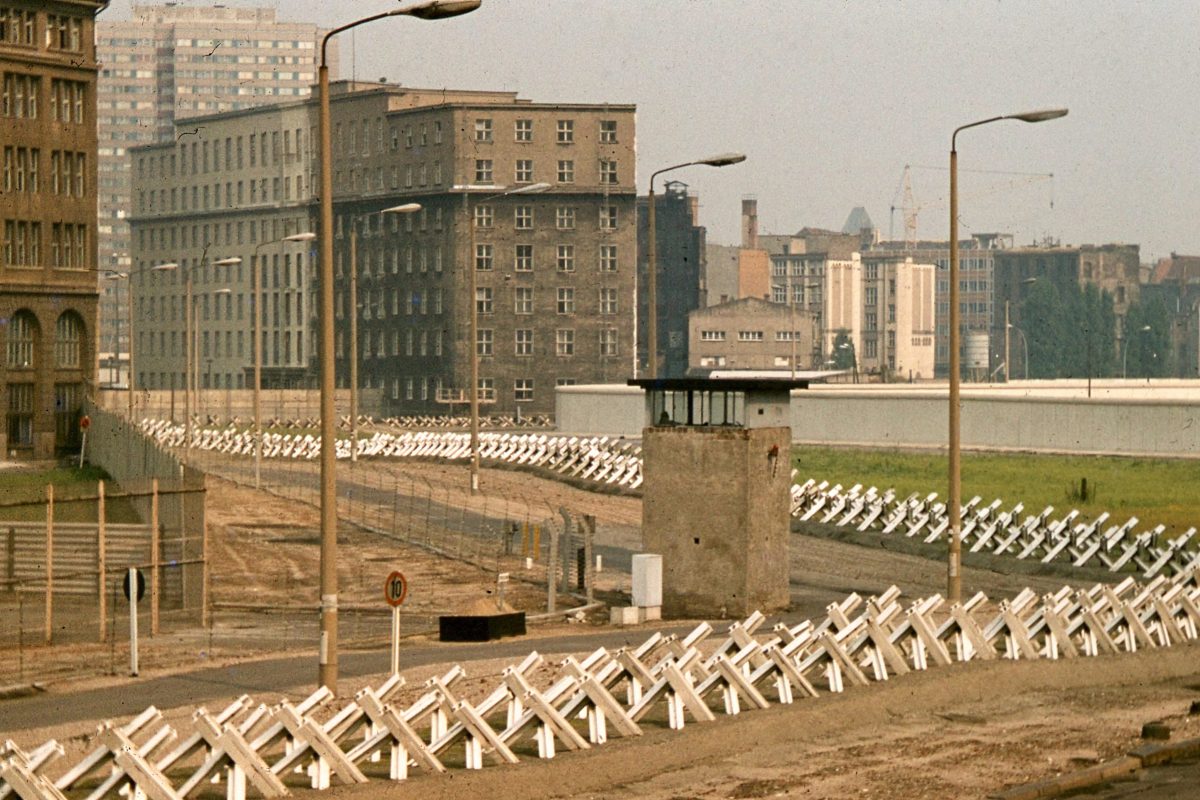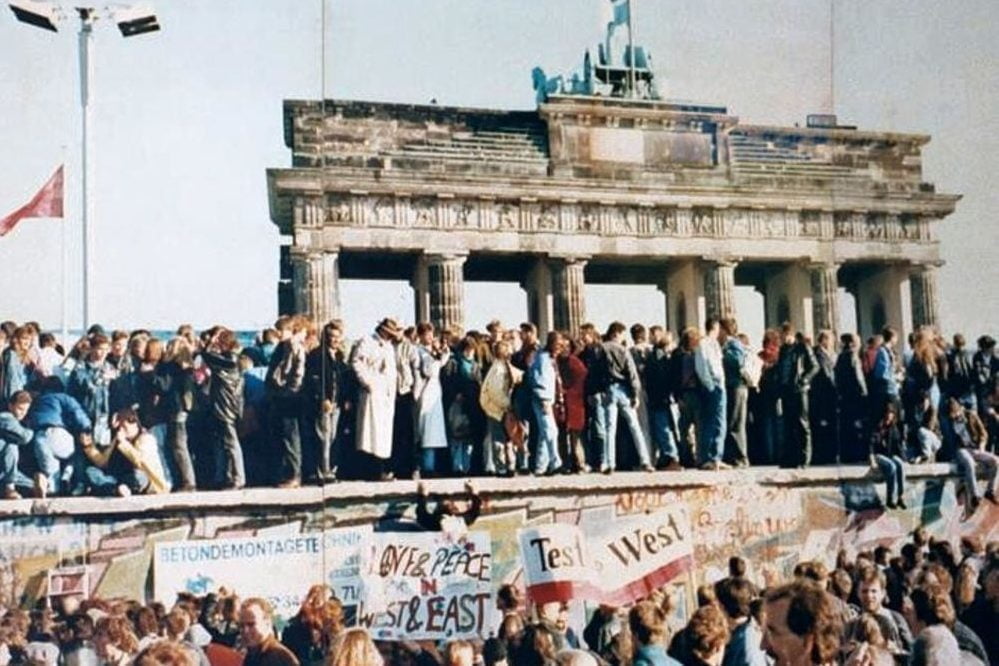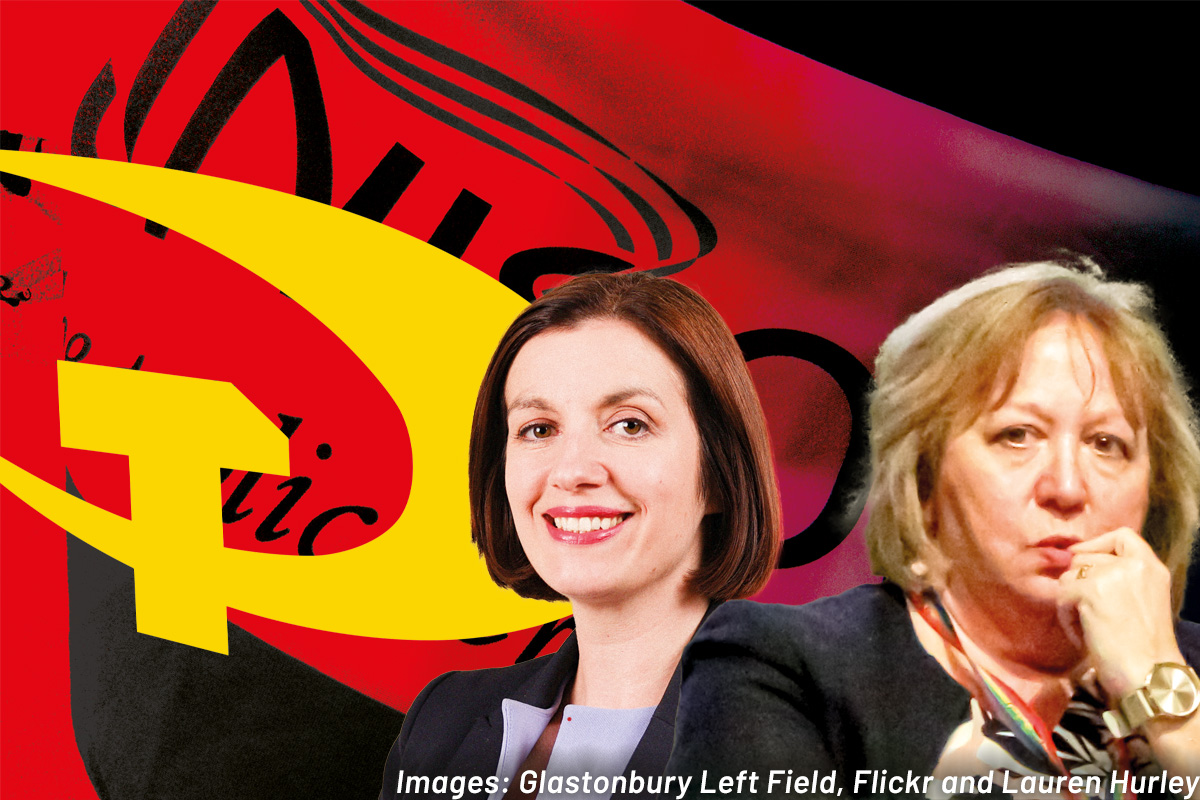The fall of the Berlin Wall 30 years ago in November 1989 has gone down in history as – for the capitalist establishment anyway – the defining moment of the collapse of the Stalinist states and the supposed final victory of capitalism.
Yet the following three decades have introduced many millions of former Iron Curtain inhabitants (along with the rest of us) to a world of oligarchs, greed and corruption, on the one hand; and unemployment, low pay, austerity cuts in public services, precarious jobs and more, on the other. The huge illusions in the West, liberalism, and capitalism have been well and truly shattered.
Many, especially the youth, are turning once again to the ideas of Marxism: not those of the rotten bureaucratic system of Stalinism which once ruled over them, but the genuine ideas of Marx, Engels, Lenin and Trotsky.
In this adapted article, based on text written in 2009, Alan Woods explains the real background to the events which led to the fall of the Wall and the Stalinist system across Europe, and shows what came of it all.
This is a year of many anniversaries, including the murder of Luxemburg and Liebknecht, the founding of the Communist International and the Asturian Commune. None of these anniversaries find any echo in the capitalist press. But there is one anniversary they will not forget: On 9 November, 1989, the Border separating Western from Eastern Germany was effectively opened.
The fall of the Berlin Wall has passed into history as a synonym for the collapse of “Communism”. In the following decades since those momentous events, we have witnessed an unprecedented ideological offensive against the ideas of Marxism on a world scale. This event was held up as decisive proof of the death of Communism, Socialism and Marxism. Not long ago, it was even presented as the end of history. But since then the wheel of history has turned several times.
The argument that henceforth the capitalist system was the only alternative for humanity has been exposed as hollow. The truth is very different. Just twenty years after the collapse of Stalinism, capitalism found itself in its deepest crisis since the Great Depression. Millions are still faced with a future of unemployment, poverty, cuts and austerity, all flowing from this never-ending crisis.
This vicious anti-Communist campaign has been intensified during the last period. The reason for this is not difficult to understand. The worldwide crisis of capitalism has given rise to a general questioning of the “market economy”. There is a revival of interest in Marxist ideas, which is alarming the bourgeoisie. The endless campaign of slanders is a reflection of fear.
Bureaucratism
 What failed in Russia and Eastern Europe was not communism or socialism, in any sense that this was understood by Marx or Lenin, but a bureaucratic and totalitarian caricature.
What failed in Russia and Eastern Europe was not communism or socialism, in any sense that this was understood by Marx or Lenin, but a bureaucratic and totalitarian caricature.
Lenin explained that the movement towards socialism requires the democratic control of industry, society and the state by the proletariat.
Genuine socialism is incompatible with the rule of a privileged bureaucratic elite, which will inevitably be accompanied by colossal corruption, nepotism, waste, mismanagement and chaos.
The nationalised planned economies in the USSR and Eastern Europe achieved astonishing results in the fields of industry, science, health and education. But, as Trotsky predicted as early as 1936, the bureaucratic regime ultimately undermined the nationalised planned economy and prepared the way for its collapse and the return of capitalism.
In the 1980s, the USSR had more scientists than the USA, Japan, Britain and Germany combined, and yet was unable to achieve the same results as the West. In the vital fields of productivity and living standards the Soviet Union lagged behind the West. The main reason was the colossal burden imposed on the Soviet economy by the bureaucracy – the millions of greedy and corrupt officials that were running the Soviet Union without any control on the part of the working class.
The suffocating rule of the bureaucracy eventually led to a sharp fall in the rate of growth in the USSR. As a result, the Soviet Union was falling behind the West. The costs of maintaining high levels of military expenditure and the costs of maintaining its grip on Eastern Europe imposed further strains on the Soviet economy. The emergence of a new Soviet leader, Mikhail Gorbachev, in 1985 signalled a major turn in the situation.
Gorbachev represented that wing of the Soviet bureaucracy that stood for reform from the top in order to preserve the regime as a whole. However, the situation deteriorated further under Gorbachev. This inevitably led to a crisis, which had an immediate effect in Eastern Europe, where the crisis of Stalinism was exacerbated by the national question.
Mass Uprisings
In 1989, from one capital to another, a tidal wave of revolt spread, overthrowing one by one the Stalinist regimes. In Romania, Ceausescu was overthrown by a revolution and sent to a firing squad. A key factor in the success of the popular uprisings was the crisis in Russia. In the past Moscow had sent the Red Army to crush uprising in East Germany (1953), in Hungary (1956) and Czechoslovakia (1968). But Gorbachev understood that this option was no longer possible.
The mass strikes in Poland in the first part of the 1980s were an early expression of the impasse of the regime. If this magnificent movement had been led by genuine Marxists, it could have prepared the ground for a political revolution, not only in Poland but throughout Eastern Europe. But in the absence of such a leadership, the movement was derailed by counterrevolutionary elements like Lech Walesa.
At first, the Polish Stalinists tried to hold the movement down through repression, but in the end Solidarity had to be legalized and allowed to participate in parliamentary elections on June 4, 1989. What followed was a political earthquake. Solidarity candidates captured all the seats they were allowed to contest. This had a profound effect in the neighbouring countries.
In Hungary Janos Kadar – in anticipation of what was to come ‑ had already been removed as General Secretary of the Communist Party the previous year in 1988 and the regime had adopted a “democracy package”, including elections. Czechoslovakia was very soon also affected and by November 20,1989, the number of protesters assembled in Prague went from 200,000 the previous day to half-million. A two-hour general strike was held on 27 November.
These dramatic events marked a major turning-point in history. For almost half a century after World War II the Stalinists had ruled Eastern Europe with an iron hand. These were monstrous one-Party states, backed by a powerful apparatus of repression, with army, police and secret police, and informers in every block of flats, school, college or factory workshop. It seemed almost impossible that popular uprisings could ever succeed against the power of a totalitarian state and its secret police. But in the moment of truth these apparently invincible regimes were shown to be giants with feet of clay.
The Berlin Wall
 Of all the regimes of Eastern Europe, the German Democratic Republic was one of the most industrially and technologically advanced. The standard of life, although not as high as in West Germany, was good. There was full employment, and everyone had access to cheap housing, free medicine and education of a high standard.
Of all the regimes of Eastern Europe, the German Democratic Republic was one of the most industrially and technologically advanced. The standard of life, although not as high as in West Germany, was good. There was full employment, and everyone had access to cheap housing, free medicine and education of a high standard.
However, the rule of a totalitarian one-Party state, with its ever-present secret police (the notorious Stasi) with its army of informers, the corruption of the officials, and the privileges of the elite, were a source of discontent. Before the erection of the Berlin Wall in 1961, about 2.5 million East Germans had emigrated to West Germany, many over the border between East and West Berlin. In order to halt this haemorrhage, the regime had the Berlin Wall built.
The Wall and other fortifications along the 860-mile border shared by East and West Germany succeeded in stemming the exodus. This action probably helped to boost economic growth in the GDR. But it caused suffering and hardship for the families that were divided and it was a propaganda gift to the West, which presented it as yet another example of “Communist tyranny”.
By the end of the 1980s the situation in the GDR was explosive. The old Stalinist Erich Honecker was implacably opposed to reform. His regime even prohibited the circulation of “subversive” publications from the Soviet Union.
On 6 October and 7 October, Gorbachev visited East Germany to mark the 40th anniversary of the German Democratic Republic, and he put pressure on the East German leadership to accept reform. He is quoted as saying: “Wer zu spät kommt, den bestraft das Leben” (He who is too late is punished by life).
Losing control
By now the East German people had become openly rebellious. Opposition movements began to sprout up like mushrooms. These included the Neues Forum (New Forum), Demokratischer Aufbruch (Democratic Awakening), and Demokratie Jetzt (Democracy Now). The largest opposition movement was created through a Protestant church service at Leipzig’s Nikolaikirche, German for Church of Saint Nicholas, where each Monday after service citizens gather outside demanding change in East Germany. However, these movements were confused and politically naïve.
A wave of mass demonstrations now swept through East German cities, acquiring particular strength in Leipzig. Hundreds of thousands of people joined these demonstrations. The regime entered into crisis that led to the removal of the hard-line Stalinist leader, Erich Honecker, and the resignation of the entire cabinet. Under the pressure of the mass movement, the new Party leader, Egon Krenz, called for democratic elections. But the reforms proposed by the regime were too little and too late.
The “Communist” leaders considered using force but changed their mind (with a little prodding from Gorbachev). Events were now spinning out of control. In the following days, one could almost speak of anarchy: Shops stayed open all hours, a GDR passport served as a free ticket for public transport.
In the words of one observer: “in general there were more exceptions than rules in those days”. Power was lying in the street, but there was nobody to pick it up.
Faced with a mass revolt, the seemingly all-powerful East German state collapsed like a house of cards.
On 9 November, 1989, after several weeks of mass unrest, the East German government announced that all GDR citizens could visit West Germany and West Berlin. This was the signal for a new eruption of the masses. Spontaneously, crowds of East Germans climbed onto and crossed the Wall, joined by West Germans on the other side.
The Berlin Wall was a symbol and a focal point for all that was hated about the East German regime. The demolition of the Wall began quite spontaneously. Over the next few weeks, parts of the Wall were chipped away. Later on industrial equipment was later used to remove almost all of the rest. There was a celebratory atmosphere, a mood of euphoria, more like a carnival than a revolution. But that is true of the early stages of every great revolution, beginning with 1789.
In November of 1989, the population of the GDR was overwhelmed by emotional moods – a sense of liberation, accomplished by a general feeling of elation. It was as if a whole nation was experiencing a general inebriation, and therefore was open to suggestions and sudden impulses. Overthrowing the old regime proved far easier than anyone had dared imagine. But, once having overthrown it, what was to be put in its place? The masses that had brought about the overthrow of the old regime, knew very well what they did not want, but did not have quite clear what they wanted, and nobody was offering a way out.
All the objective conditions for a political revolution were now given. The great majority of the population did not want the restoration of capitalism. They wanted socialism, but with democratic rights, without the Stasi, without corrupt bureaucrats and without a dictatorial one-party state. If a genuine Marxist leadership had existed, this could have led to a political revolution and the establishment of a workers’ democracy.
Counter-revolution
However, the fall of the Berlin Wall did not result in a political revolution but counterrevolution in the form of unification with West Germany. This demand did not feature prominently at the beginning of the demonstrations. But given the absence of a clear programme on the part of the leadership, it was introduced and gradually came to occupy a central role.
Most of the leaders of the opposition had no clear programme, policy or perspective, beyond a vague desire for democracy and civil rights. Like nature, politics abhors a vacuum. The presence of a powerful and prosperous capitalist state next door therefore played a determining role in filling the vacuum.
West German Chancellor Helmut Kohl was an aggressive representative of imperialism. He used the most shameless bribery to persuade the East German people to agree to immediate unification, offering to exchange their Ostmarks for Deutschmarks on a one-to-one basis. But what Kohl did not tell the people of East Germany was that unification would not mean that they would have West German living standards.
In July 1990, the final obstacle to German unification was removed when Gorbachev agreed to drop Soviet objections to a reunited Germany within NATO in return for substantial German economic aid to the Soviet Union. Unification was formally concluded on October 3, 1990.
Deception
The people of the GDR had been deceived. They were not told that the introduction of a market economy would mean mass unemployment, factory closures and the virtual destruction of large parts of the industrial base of the GDR, or a general rise in prices, and the demoralization of a section of the youth, or that they would be looked down upon as second-class citizens in their own country. They were not told these things but they have found them out through bitter experience.
Reunification precipitated a disastrous collapse in real Eastern German GDP, with falls of 15.6 per cent in 1990 and 22.7 per cent in 1991 cumulating to a one third decline. Millions of jobs were lost. Many eastern factories were bought by western competitors and shut down.
From 1992, East Germany experienced four years of recovery, but this was followed by stagnation.
Before the Second World War, eastern German GDP per capita was slightly above the German average, and both at that time and in the GDR, eastern Germany was richer than other eastern European countries. But 30 years after unification, living standards in East Germany still lag behind the West.
In July 1990, the “chancellor of unity”, Helmut Kohl, promised: “In a joint effort we will soon turn [the East German regions] Mecklenburg-Vorpommern and Saxony-Anhalt, Brandenburg, Saxony and Thuringia into flourishing landscapes.” Fifteen years later, a BBC report admitted that “the statistics are bleak.”
Like many other East Germans, Ralf Wulff said he was delighted about the fall of the Berlin Wall and to see capitalism replace communism. But the euphoria did not last long. “It took just a few weeks to realise what the free market economy was all about,” said Wulff. “It’s rampant materialism and exploitation. Human beings get lost. We didn’t have the material comforts but communism still had a lot going for it.” (Reuters report)
A poll by Der Spiegel stated that 73% of East Germans believed that Karl Marx’s critique of capitalism is still valid.
“Everyone thought there would never ever again be any demand for ‘Das Kapital’,” managing director Joern Schuetrumpf told Reuters. “Even bankers and managers are now reading Das Kapital to try to understand what they’ve been doing to us. Marx is definitely ‘in’ right now,” he said.
The crisis of capitalism has convinced many Germans, both East and West, that the system has failed. “I thought communism was shit but capitalism is even worse,” said Hermann Haibel, a 76-year old retired blacksmith. “The free market is brutal.”
What this clearly shows is that the people of East Germany do not want capitalism but socialism – not the bureaucratic totalitarian caricature of socialism that they had before, but genuine democratic socialism – the socialism of Marx, Engels, Liebknecht and Luxemburg.






